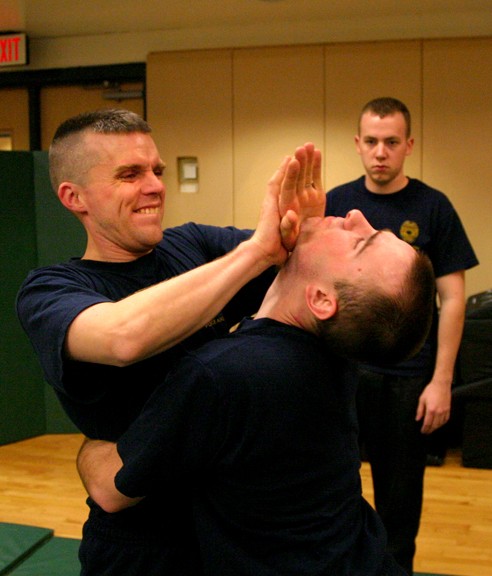In a matter of months, they will have endured hours of military-style physical training, memorized and recited a one-page creed of values and walked through the Holocaust Museum as a reminder that their No. 1 priority is to protect the community.
They will become University Police officers.
Maj. James Hamrick, who runs the grueling and sometimes melodramatic 20-week officer training school, said the Holocaust Museum shows student officers the result of German officers losing sight of priorities under Adolf Hitler’s reign. Hamrick will spend the next 17 weeks preparing the 10 officers to join the police force in the next six months, filling one of the largest staffing shortages the department has faced since the 1980s.
The realities of the world after horrific criminal acts, such as the Columbine High School shooting and Washington area sniper shootings, pushed University Police to make sweeping changes in their training tactics to include methods that a decade ago were used only by SWAT teams and other highly-trained forces.
Student officers undergo rigorous physical training, running laps around Fraternity Row in the mornings and carrying around a brick for an entire day when they do something wrong.
University Police Chief Ken Krouse chose Hamrick to run the 22nd police academy class at the Patapsco Building on Paint Branch Parkway near the College Park Metro Station police believed military-style training tactics were the best way to ensure officers were professional, disciplined, courageous and personally motivated.
The program started Jan. 24 with 11 student officers. Three weeks later, after two quit and one replacement was selected, there were 10. Hamrick said those who quit just weren’t cut out for the job.
Students who show up to class late or don’t pay full attention during training carry the brick at all times.
“It’s symbolic of bearing the consequences of their negligence,” Hamrick said.
At about 8 a.m., student officers, dressed in navy blue utility uniforms and shiny black shoes, stand in formation at the academy while three drill instructors wearing flat-brimmed military hats inspect their appearance and uniforms.
If their appearances or uniforms are lacking in any way, drill instructors can issue them a minor infraction.
Three minor infractions is equivalent to one demerit. After. five demerits, the student officer is “terminated,” or kicked out of the academy.
After the uniform inspection, officers recite the one-page creed that sums up the academy’s philosophy of integrity, courage, camaraderie and discipline. Within a few weeks, they must recite it from memory.
Training also includes written and physical examinations.
“You guys said you wanted to be here. Prove it!” said master patrol officer Ross Bogash to a group of officers going through a cycle of jumping jacks, push-ups, leg-lifts and sprints.
Their navy blue sweatpants were drenched with perspiration, and their grunts and yells drowned out the sound of passing traffic on Route 1.
Bogash said the physical training wasn’t nearly as intense when he went through the academy in 2001.
In coming weeks, the trainees will also learn hand-to-hand combat, proper driving techniques and how to deal with stress.
In addition to visiting the Holocaust Museum, Hamrick said he and other instructors will take their students to the state coroner’s office to observe how they react to dead, mutilated bodies in a controlled environment potentially preventing officers from overreacting when they come upon similar things while on patrol.
In the last two weeks of their approximately 800 total hours of training, Hamrick said he is considering testing the students with a series of simulation calls that will help determine whether the training worked.
Student officers will carry real guns filled with small, accurate plastic pellets — somewhat like paintball guns — during the simulation tests.
Some simulation calls include dealing with a threatened suicide and active-shooter scenarios. Academy instructors and other officers will play the victims.
After they finish at the academy, the officers will go through six to 12 weeks of field training, where they will likely ride with other officers to start applying what they’ve learned at the academy.
Officers are trained in the use of deadly force and will spend roughly 80 hours at a shooting range to familiarize themselves with guns.
“The stark reality is that we confront people who want to harm. There are wolves among us. We have to protect the sheep in the community,” Hamrick said, using a metaphor from a six-part video series he presented to the students on the use of deadly force.
Student officers run near Ritchie Coliseum.
Student officers Ryan Peck (left) and Robert Defibaugh practice close combat.





